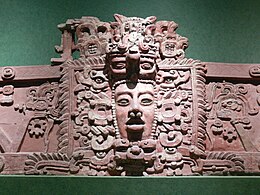
Xunantunich is an Ancient Maya archaeological site in western Belize, about 70 miles (110 km) west of Belize City, in the Cayo District. Xunantunich is located atop a ridge above the Mopan River, well within sight of the Guatemala border – which is 0.6 miles (1 km) to the west. It served as a Maya civic ceremonial centre to the Belize Valley region in the Late and Terminal Classic periods. At that time, when the region was at its peak, nearly 200,000 people lived in the Belize Valley.
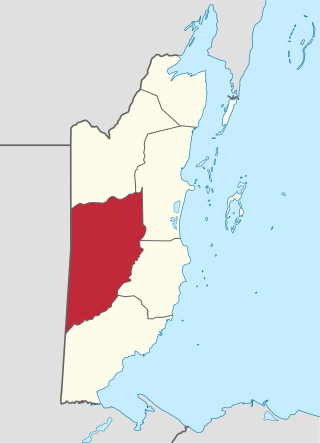
Cayo District is a district located in the west part of Belize. It is the most extensive, second-most populous and third-most densely populated of the six districts of Belize. The district's capital is the town of San Ignacio.
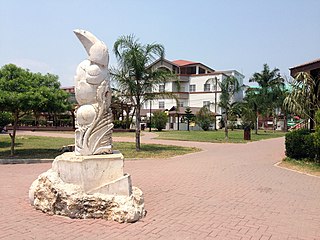
San Ignacio and Santa Elena are towns in western Belize. San Ignacio serves as the cultural-economic hub of Cayo District. It got its start from mahogany and chicle production during British colonisation. Over time it attracted people from the surrounding areas, which led to the diverse population of the town today. San Ignacio is the largest settlement in Cayo District and the second largest in the country, after Belize City.
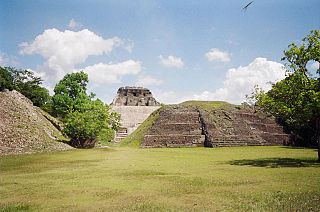
The Maya ruins of Belize include a number of well-known and historically important pre-Columbian Maya archaeological sites. Belize is considered part of the southern Maya lowlands of the Mesoamerican culture area, and the sites found there were occupied from the Preclassic until and after the arrival of the Spanish in the 16th century.

Cahal Pech is a Maya site located near the town of San Ignacio in the Cayo District of Belize. The site was a palatial, hilltop home for an elite Maya family, and though the most major construction dates to the Classic period, evidence of continuous habitation has been dated to as far back as 1200 BCE during the Early Middle Formative period, making Cahal Pech one of the oldest recognizably Maya sites in Western Belize.
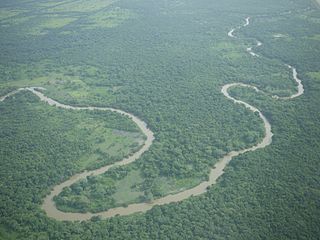
The Belize River runs 290 kilometres (180 mi) through the center of Belize. It drains more than one-quarter of the country as it winds along the northern edge of the Maya Mountains to the sea just north of Belize City. The Belize river valley is largely tropical rain forest.

Actun Tunichil Muknal, also known locally as ATM, is a cave in Belize, near San Ignacio, Cayo District, notable as a Maya archaeological site that includes skeletons, ceramics, and stoneware. There are several areas with skeletal remains in the main chamber. The best known is "The Crystal Maiden", the skeleton of what is believed to be a 17-year-old boy, possibly a sacrifice victim, whose bones have been calcified to a sparkling, crystallized appearance.
Belize Botanic Gardens (BBG) is 45 acres (18 ha) of native and exotic plants growing in the Cayo district of western Belize. The garden is in a valley on the banks of the Macal River, surrounded by the Maya Mountain foothills.

The Macal River is a river running through Cayo District in western Belize. Sites along the river include the ancient Mayan town of Cahal Pech and the Belize Botanic Gardens. The Macal River discharges to the Belize River. There are several tributaries to the Macal River including the following streams: Privassion, Rio On, Rio Frio, Mollejon and Cacao Camp.

The Mopan River is a river in Central America spanning the Petén Department of Guatemala and the Cayo District of Belize. It merges with the Macal River at Branch Mouth, Belize, forming the Belize River, which ultimately discharges to the Caribbean Sea. The drainage area of the combined watershed is 9,434.2 km2 (3,642.6 sq mi). Tributaries of the Mopan include Chiquibul Branch, Ceiba Grande, Salisipuedes, and Delores.

Mountain Pine Ridge Forest Reserve is a nature reserve in the Cayo District of southern central Belize. It was established in 1944 to protect and manage the native Belizean pine forests. Its boundaries are poorly defined, but it is estimated to cover an area of 106,352.5 acres (430 km2), although much of the reserve has been leased.

The Pre-Columbian Belize history is the period from initial indigenous presence, across millennia, to the first contacts with Europeans - the Pre-Columbian or before Columbus period - that occurred on the region of the Yucatán Peninsula that is present day Belize.
The Rio Bravo Conservation and Management Area is a nature reserve located in northwestern Belize. Rio Bravo, as it is known, was established by Programme for Belize in 1988 with the purchase of 110,044 acres of land from Gallon Jug Agroindustries. With logging encroachment imminent in 1989, the Nature Conservancy joined Programme for Belize to protect the land. Additional land donations from Coca-Cola Foods, Inc. and purchases from New River Enterprises Ltd. enlarged the protected area to 230,875 acres (934.32 km2). Rio Bravo is the largest terrestrial conservation area in Belize, comprising 4% of the country's total land area.
Tipu is a Mayan archaeological site in the Maya Mountains near the Belize–Guatemala border. This site is situated near the Macal River. Further downstream is located the Mayan site of Chaa Creek. Slightly further downstream is the site of Cahal Pech. In Spanish colonial times, Tipu is thought to have played a major role in delaying the conquest of Peten.
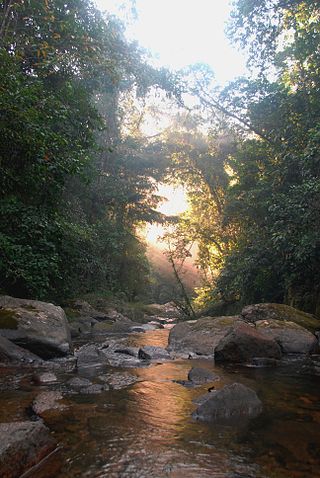
Bladen Nature Reserve is a landscape of caves, sinkholes, pristine streams and rivers, undisturbed old growth rainforest and an abundance of highly diverse flora and fauna which includes a great deal of rare and endemic species.
The Lodge at Chaa Creek is an eco-resort and 400-acre private nature reserve located in the Cayo District of Belize, Central America. Established as a small family farm in 1981, it has grown to be one of Belize’s most recognized resorts. It has also received international recognition as a model for sustainable tourism and responsible travel by Conde Nast, National Geographic Adventure, Travel and Leisure magazines, and other publications and organizations. Chaa Creek runs educational and natural history programs with a focus on Belize's Maya culture and civilization.
Pook's Hill is a private forest reserve, bird sanctuary, and archaeological site in Cayo District, Belize, 12 miles (19 km) west of Belmopan. The Mayan site contains temples, a plazuela, midden, banquet hall, and burial sites. Facilities within the reserve include Pook's Hill Lodge, an ecotourism resort.
Jaime José Awe is a Belizean archaeologist who specializes in the ancient Maya, a Professor of Anthropology at Northern Arizona University, and the Director of the Belize Valley Archaeological Reconnaissance Project.
Midnight Terror Cave is a cave in central Belize that was discovered in 2006 near Springfield. The site was worked on by California State University, Los Angeles' field school as part of the Western Belize Regional Cave Project under Dr. Jaime Awe. The cave contained around 9000 human bones, from at least 118 individuals, and is one of the largest sacrificial assemblages ever discovered in the Maya Lowlands.
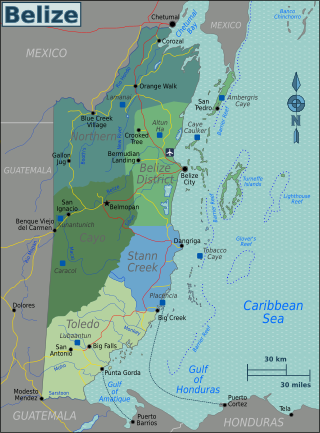
Buenavista del Cayo is a classic period Mayan urban center located in the Mopan River Valley of Belize. The site dates to 300-900AD and was used as a marketplace for merchants to sell material goods. Data suggests that the plazas were in use from the Middle Preclassic through the Terminal Classic Periods. The Maya lowlands fostered a diverse economy of individuals with different economic goals. Buenavista del Cayo attracted both merchants and consumers from other settlements in the surrounding valley. Evidence found at the site suggests that both practical and prestige items were sold at the marketplace, indicating the presence of both wealthy and poor individuals. Distinct platforms found in the plazas along with the differentiation of goods by material type support the theory that the site was used as a central marketplace in the Maya lowlands.
